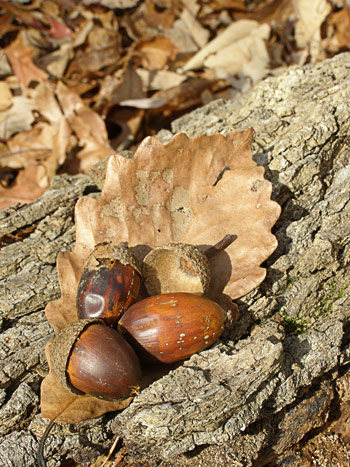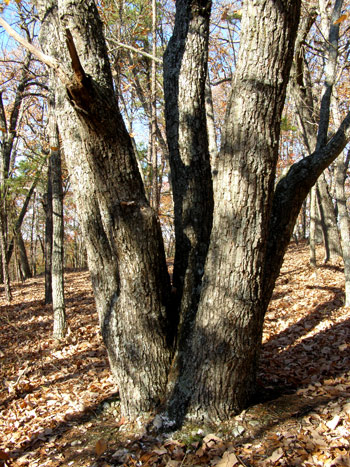Occoneechee, our biggest little mountain

Large chestnut oak acorns are essential for wildlife and a nice snack for some humans. Photo by Ken Moore
Flora Columnist
Among several little mountains scattered about the county, the tallest, at 867 feet, occupies Occoneechee Mountain State Natural Area near Hillsborough.
For folks out for a vigorous walk, there are several miles of up-and-down terrain to satisfy the most active. For those who enjoy poking along to see what one can see, several hours can pass by quickly.
It’s the most biologically diverse natural area in our region with several rare plant and animal species identified by the N.C. Natural Heritage Program.
From the high dry (xeric) Chestnut Oak Forest to the Piedmont Bottomland Forest, there are at least seven distinct plant communities, including extensive mountain laurel thickets so evident in the winter, and a lush fern glade evident spring through fall.
Whenever one explores the mountain, there are multiple discoveries to be made along the way. During the warm months, butterfly enthusiasts will be eager to spot brown elfin butterflies that feed on huckleberries and lowbush blueberries, as well as the sleepy duskywings that feed on leaves of the chestnut oak. Both of these little brown butterfly species are unusual for this area.
You can count on the mountain laurel being in flower every Mother’s Day weekend.
My favorite time of year on the mountain is winter because it’s fully visible. Rock boulders scattered atop the summit and ridges invite exploration. Resting on any of those boulders, one will likely marvel at the massive rock chestnut oaks, Quercus prinus, that dominate the forest.
Some of those trees must be up to 200 years old. You’ll likely be curious about the contorted appearance of some that have three, four and even five massive trunks radiating from the base. This oak is noted for sprouting vigorously from the ground if injured by fire or harvested for its timber.

An impressive multi-trunk chestnut oak “sprout†resulting from a fire long ago Photo by Ken Moore
The forest floor this time of year is a lovely thick carpet of mostly chestnut oak leaves. Beneath the leaves in some spots you’ll find large, 1-to-2-inch-long acorns beginning to sprout a little tap root. Like the white oaks, these acorns are edible and worth the effort to roast a few for winter snacks.
Occoneechee is steeped in history, beginning with the Native Americans who named it. There’s an abandoned quarry dating back to the 1880s on one side of the mountain and a present-day active pyrophyllite mine on another side. Curiously associated with the mountain’s erosion-resistant quartz rock is the soft phyrophyllite being quarried for the manufacturing of products ranging from soft, fine talcum powder to heat-resistant electrical insulators.
The more than 630-million-year-old geological story of the Occoneechee area is beautifully described and illustrated in the N.C. Geological Survey’s Information Circular 35, A Geologic Adventure Along the Eno River, by geologist Philip J. Bradley. It’s a very readable resource. (geology.enr.state.nc.us). In addition to descriptions of rock types and geologic history, the publication contains guides to the geology of four popular trails along the Eno River.
I recommend at least monthly explorations of Occoneechee, our highest little mountain.
Please note: Guided walks scheduled this month include a geology hike on Dec. 17 at 2 p.m. and a Christmas sunset hike on Dec. 22 at 5 p.m. Call 383-1686 to register.
Email Ken Moore at flora@carrborocitizen.com. Find previous Ken Moore Citizen columns at The Annotated Flora (carrborocitizen.com/flora).


Comments are closed.